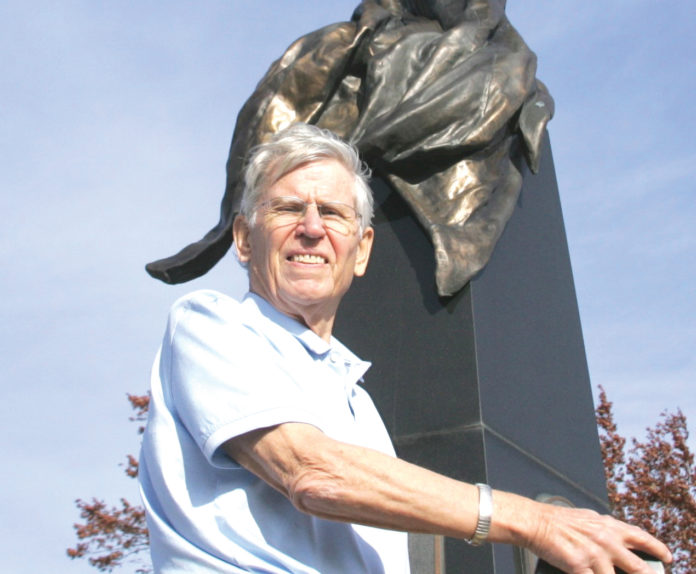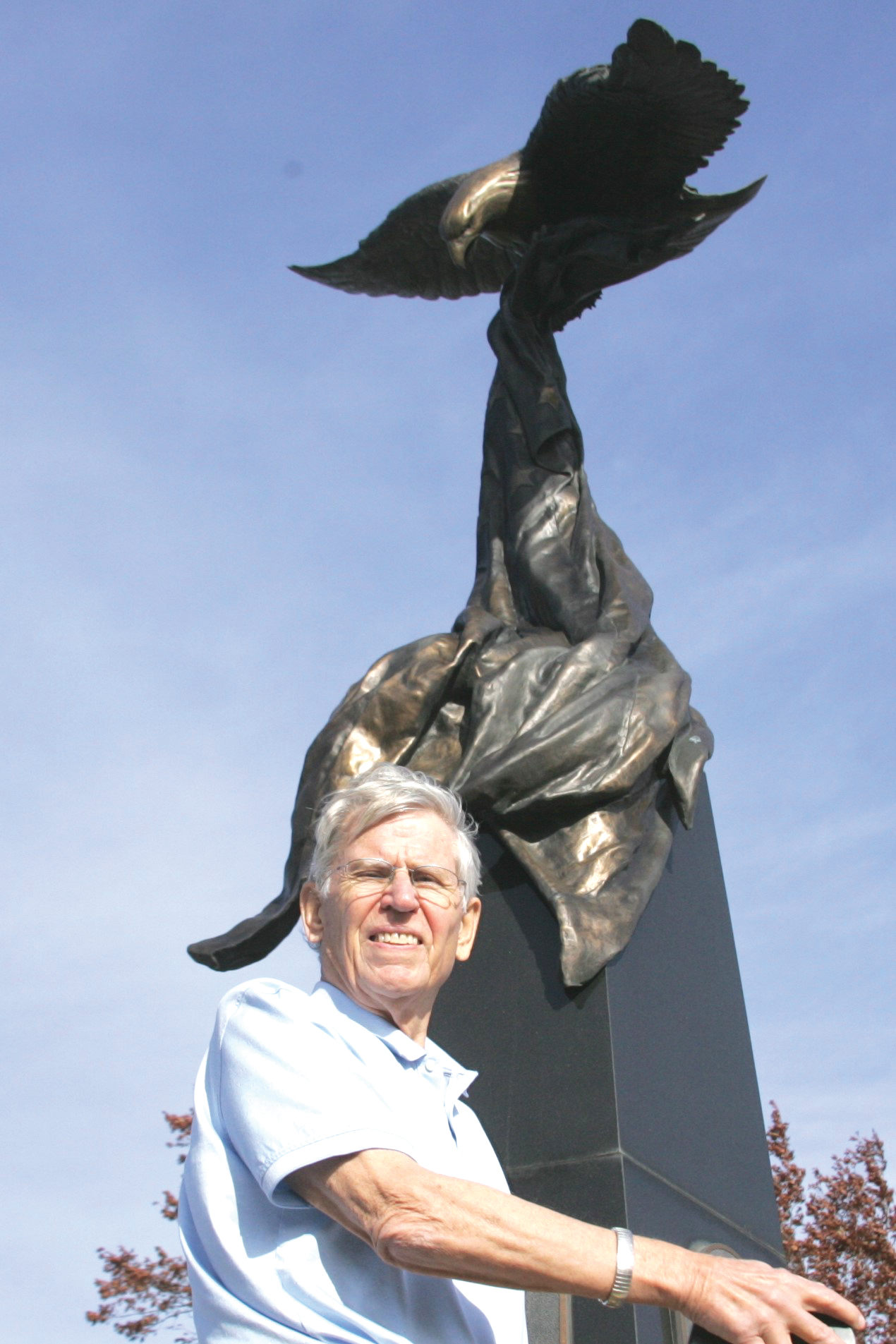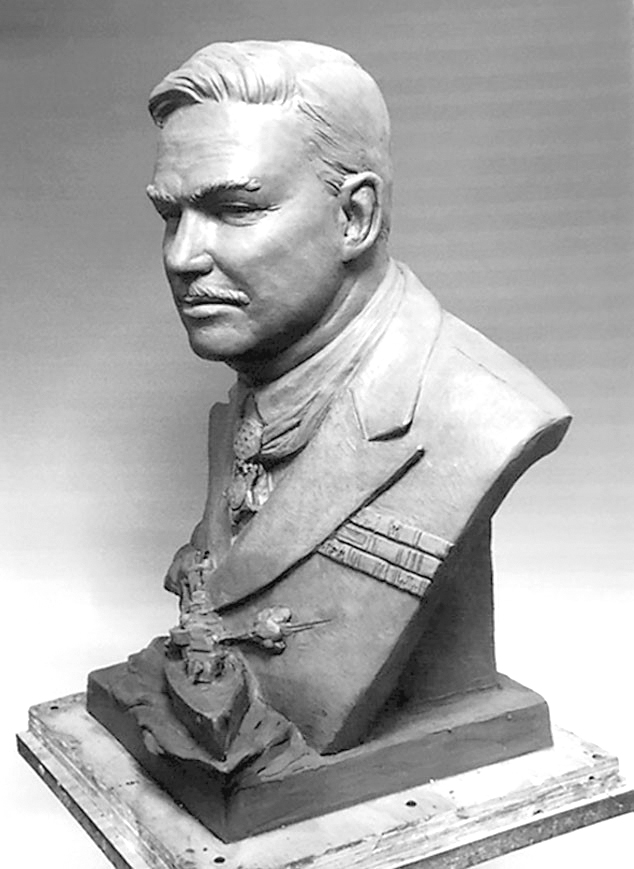
Story and photos by Darl DeVault


A retired U.S. Air Force lieutenant colonel and dentist, Norman resident Stephen Reagan is expanding his daily volunteer work helping fellow veterans. For several years he has volunteered helping veterans file their VA claims at the Dale K. Graham Veterans Foundation. Now he is volunteering to help honor a long-deceased Oklahoma veteran—U.S. Navy Commander Ernest E. Evans, who earned the Medal of Honor for heroism in WWII.
Since its beginning, the veteran’s organization has helped more than 25,000 veterans file their benefits claims with the Veterans Administration. Its impact spans all 77 counties in Oklahoma, 45 states, and four foreign countries.
Segueing from helping at the foundation several mornings per week to raising funds to honor Muskogee High graduate Ernest Evans’ heroism has been a change of pace. Reagan, 74, plans to ramp up his fundraising efforts to find a suitable setting for a bronze bust of Evans in 2021.
“I was inspired to do this because Evans was the commander of the destroyer USS Johnston in the Battle off Samar where his heroic actions are as impressive as any war story I have ever heard,” Reagan said recently.
Fortunately, widely acclaimed Norman sculptor Paul Moore sees Reagan’s patriotic vision. He has sculpted the bust with the USS Johnston (DD 557) in miniature at the base in clay. This act of patriotism on Moore’s part gives Reagan’s mission a real boost of professional credibility.
Upon first learning of Evans’ heroism and Reagan’s mission to honor him, Moore was immediately on board, to use a nautical phrase. Evans’ bronze bust will be accompanied by an informational plaque on a granite pedestal. A clay model has already been completed. “I am grateful a talented and famous Oklahoma sculptor like Paul Moore sculpted the bronze bust,” Reagan said.
Of Native American heritage, Evans was largely forgotten in his home state because he left Oklahoma in the mid-1920s for the Navy. He only returned for visits with his mother and siblings in the Tulsa area. He was initially awarded the Navy Cross for his gallantry, but this was upgraded to our nation’s highest military distinction at the end of WWII.
His story of heroism first resonated with Reagan in 2008. “I read about Evans in an excellent book by James Hornfischer, The Last Stand of the Tin Can Sailors, which tells the story of one of the largest naval battles in history.”
The author describes the battle near the Philippine Islands in late October 1944. A Navy taskforce called Taffy 3 was assigned to protect the U.S. Army troops committed to the vital landing on the Philippines with General Douglas McArthur. Taffy 3 was to shield the vulnerable transports of the Leyte Gulf invasion fleet.
Taffy 3 consisted of six escort aircraft carriers (known as jeep carriers), three destroyers, and four destroyer escorts. The lightly armored, smallish escort carriers were lightly armed. They were built on commercial hulls, as platforms to launch aircraft. The destroyers and destroyer escorts were assigned to protect the escort carriers.
Early in the morning of October 25, off the island of Samar, the Imperial Japanese Navy “Center Force A” appeared on the horizon with no warning.
The Japanese force consisted of 23 ships, including four battleships and six heavy cruisers. Led by the super battleship Yamato, the largest and most-heavily gunned ship ever built, the Japanese display of force strength was a daunting sight.
This battle has been cited by naval historians as one of the greatest mismatches in history. Taffy 3 was there to provide the landings shore support and screen as an anti-submarine patrol. The group was never envisioned as a force capable of mounting fleet-level combat with battleships.
The USS Johnston, a Fletcher-class destroyer under Commander Evans, was the first American ship to attack the Japanese fleet. Without being ordered to attack, Evans sailed straight for the enemy against impossible odds. It was a suicide mission.
This bravery was foretold during the Johnston’s commissioning ceremony in October of 1943. New Commanding Officer Evans told sailors assigned to the ship: “This is going to be a fighting ship. I intend to go in harm’s way, and anyone who doesn’t want to go along had better get off right now.” His sailors remained at their stations.
He ordered a smoke screen to protect himself and the rest of Taffy 3 and the wind made it effective. He first made a torpedo run toward a Japanese heavy cruiser and sank it. Being the first to attack, all this time the Johnston was taking heavy shell fire. Out of torpedoes, Evans continued to attack the Japanese with his five-inch guns.
After about two hours of fighting, the Johnston’s steering was knocked out as well as its communications. Wounded when the ship’s bridge was destroyed, Evans moved to the rear of the ship. From the fantail he controlled the ship by shouting orders through an open hatch to sailors turning the rudder by hand below.
A short while later the Johnston was dead in the water. Three hours after the battle began, a Japanese ship approached to point blank range and sank the destroyer. But by then the delaying action by the Johnston’s heroic crew and the sailors of the other small fighting ships had allowed all but one the jeep carriers to escape. The escort aircraft carrier USS Gambier Bay was sunk.
“This brief description doesn’t do justice to the heroism of Evans and his crew,” Reagan said. “The USS Johnston, with the other ships and planes of Taffy 3, fought so fiercely they surprised the Japanese. They thought they were fighting a much larger American force and retreated.”
Evans went down with his ship. His body was never recovered. Late in 1945 he was posthumously awarded the Medal of Honor for his actions. His widow accepted the award in a ceremony near San Diego.
His actions and those of many other sailors and pilots of Taffy 3 saved the Navy from a near disaster. In addition to all earning Presidential Unit Citations, the sailors and pilots earned 22 Navy Crosses, 2 Silver Stars and 2 Bronze Stars for valor in combat operations.
Inducted into the Oklahoma Military Hall of Fame in 2009, Evans received little recognition in Muskogee and in the state until this year. The Oklahoma Historical Society published a long-overdue account of his life and heroics in a 2010 issue of the society’s historical journal, Chronicles of Oklahoma.
On Veterans Day this year Oklahoma City unveiled the Oklahoma Medal of Honor Memorial at the new 27-acre Manuel Perez Park, named for a MOH winner. Evan’s valiant fighting spirit throughout his historic naval battle is honored at the plaza there with the 32 other Oklahomans who have earned the Medal of Honor.
Commander Evans graduated from Muskogee High School in 1926 and joined the Navy as an enlisted sailor. He then made his way to the Naval Academy where in 1931 he become one of the first Native Americans to graduate. At the academy he was nicknamed “Chief.” Serving in the fleet as a junior officer, he steadily advanced in rank to commanding the Johnston in 1944.
Reagan wants to see Evans honored with a bronze bust and historic marker on a pedestal. He hopes to place it in an appropriate setting. War Memorial Park in Muskogee would be one of his choices. The bronze bust, set on a base by Willis Granite of Granite, Okla., is envisioned as a patriotic fixture in Muskogee.
Reagan was born in Norman and raised in Claremore, Okla. He attended Cameron College and the University of Arkansas, playing baseball. He joined the U.S. Air Force for four years, then graduated dental school at the University of Oklahoma College of Dentistry. He went on to serve in the Air Force for a total of 20 years.
He returned to Oklahoma to teach at the OU College of Dentistry for 20 years, where he was director of the Advanced General Dentistry Program. He has been married to his wife, Alice, for 52 years.
The cost of the project is near $40,000 for the bronze bust by Moore and the granite base. Willis Granite will do the installation. As an outdoor display, the City of Muskogee would need to provide a concrete base.













